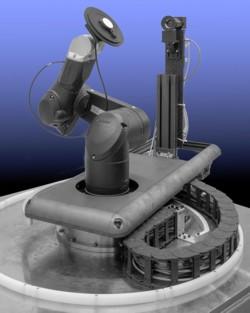Robotic Optical Scattering Instrument (ROSI)

ROSI (Robotic Optical Scattering Instrument)
ROSI performs specular and bidirectional reflectance measurements of spectrally neutral, non-fluorescent specular and diffuse samples at room temperature. It serves as the national reference instrument for specular and bidirectional reflectance measurements. The national reference instrument for directional-hemispherical reflectance measurements is the Reference Integrating Sphere for Spectral Reflectance.
ROSI uses a quasi-monochromatic system for illumination of the sample and broadband detection for the reflected radiation. Sample angles and positioning are controlled by a robotic-arm-based goniometer. Specular and bidirectional calibrations are collected in-plane, meaning the sample normal, illumination axis, and receiver axis are in the same plane. ROSI can also perform out-of-plane bidirectional reflectance measurements for research and special tests.
Video
Specifications/Capabilities
Conditions for specular and bidirectional reflectance measurements using ROSI
| Geometrical | |
|---|---|
| Illumination Angle | 0° to 80° |
| Viewing Angle | 0° to 80° |
| Sample size | 25 mm to 300 mm |
| Illumination beam size | 10 mm |
| Spectral | |
|---|---|
| Wavelength | 250 nm to 2400 nm |
| Bandwidth | 14 nm |
| Polarization | 0° to 90° linear |
| Measurand | |
|---|---|
| Quantity | |
| Specular | Reflectance |
| Bidirectional Diffuse | Reflectance Factor, BRDF |
| Technique | Absolute |
| Nominal Uncertainty (k=2) | |
| Specular | 0.2 % |
| Bidirectional Diffuse | 0.65 % |

